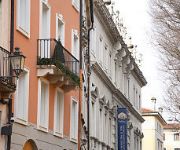Facts and Data
Webpages:
Official Unesco Page
Palladio's Italian Villas
Comune di Vicenza (only in Italian)
Palladio's Buildings
Un itinerario tra ville vicentine e committenti
Andrea Palladio
Basis Data:
Unesco World heritage since: 1994
Size of heritage: 334 ha
Coordinates:
Longitude: 11,549°
Latitude: 45,549°
Summary
Founded in the 2nd century B.C. in northern Italy, Vicenza prospered under Venetian rule from the early 15th to the end of the 18th century. The work of Andrea Palladio (1508–80), based on a detailed study of classical Roman architecture, gives the city its unique appearance. Palladio's urban buildings, as well as his villas, scattered throughout the Veneto region, had a decisive influence on the development of architecture. His work inspired a distinct architectural style known as Palladian, which spread to England and other European countries, and also to North America.
Location on Map
Show bigger map on Openstreetmap
City of Vicenza and the Palladian Villas of the Veneto
The City of Vicenza and the Palladian Villas of the Veneto is a UNESCO World Heritage site located in the Veneto region of Italy. This site encompasses the city of Vicenza and the surrounding countryside, including the Palladian Villas scattered throughout the provinces of Padua, Rovigo, Treviso, Venice, Verona, and Vicenza.
History
The history of this heritage site dates back to the Renaissance period when the city of Vicenza flourished under the rule of the Venetian Republic. It was during this time that the renowned architect Andrea Palladio left an indelible mark on the region with his innovative architectural designs.
Andrea Palladio, born in 1508, was heavily influenced by the classical architecture of ancient Rome. He developed a unique style that blended classical elements with contemporary design principles, creating a new architectural language that would have a lasting impact on Western architecture.
Palladio's designs were not limited to the city of Vicenza; he also created magnificent villas in the surrounding countryside. These villas were commissioned by wealthy Venetian families as country retreats and showcased Palladio's mastery of proportion, symmetry, and harmony.
Current State
The City of Vicenza and the Palladian Villas of the Veneto are meticulously preserved, allowing visitors to experience the architectural brilliance of Palladio and the rich history of the region.
The city of Vicenza itself is a treasure trove of Palladian architecture. The most famous landmark is the Palazzo Chiericati, which now houses the Civic Museum. This palace exemplifies Palladio's style with its harmonious proportions and elegant façade.
Another notable site in Vicenza is the Teatro Olimpico, the oldest surviving indoor theater in the world. Designed by Palladio, it showcases his mastery of perspective and illusion, creating a breathtaking theatrical experience.
As for the Palladian Villas, there are numerous examples scattered throughout the Veneto region. One of the most iconic is Villa Rotonda, located just outside Vicenza. This villa is a perfect example of Palladio's symmetrical design, with a central dome and four identical facades.
Other notable villas include Villa Barbaro in Maser, Villa Emo in Fanzolo, and Villa Pisani in Bagnolo. Each villa is a testament to Palladio's genius and offers visitors a glimpse into the opulent lifestyle of the Venetian aristocracy.
The City of Vicenza and the Palladian Villas of the Veneto continue to inspire architects and visitors alike. The harmonious blend of classical elements and innovative design principles make this UNESCO World Heritage site a must-visit destination for anyone interested in architecture and history.
Hotels and places to stay
G Boutique Hotel
Relais Santa Corona
Antico Hotel Vicenza
Campo Marzio Vicenza
Palace Hotel Conchiglia D'Oro
De La Ville
Key Hotel
Hotel Doge
Cristina
La Terrazza
Videos from the area
Videos provided by Youtube are under the copyright of their owners.





















